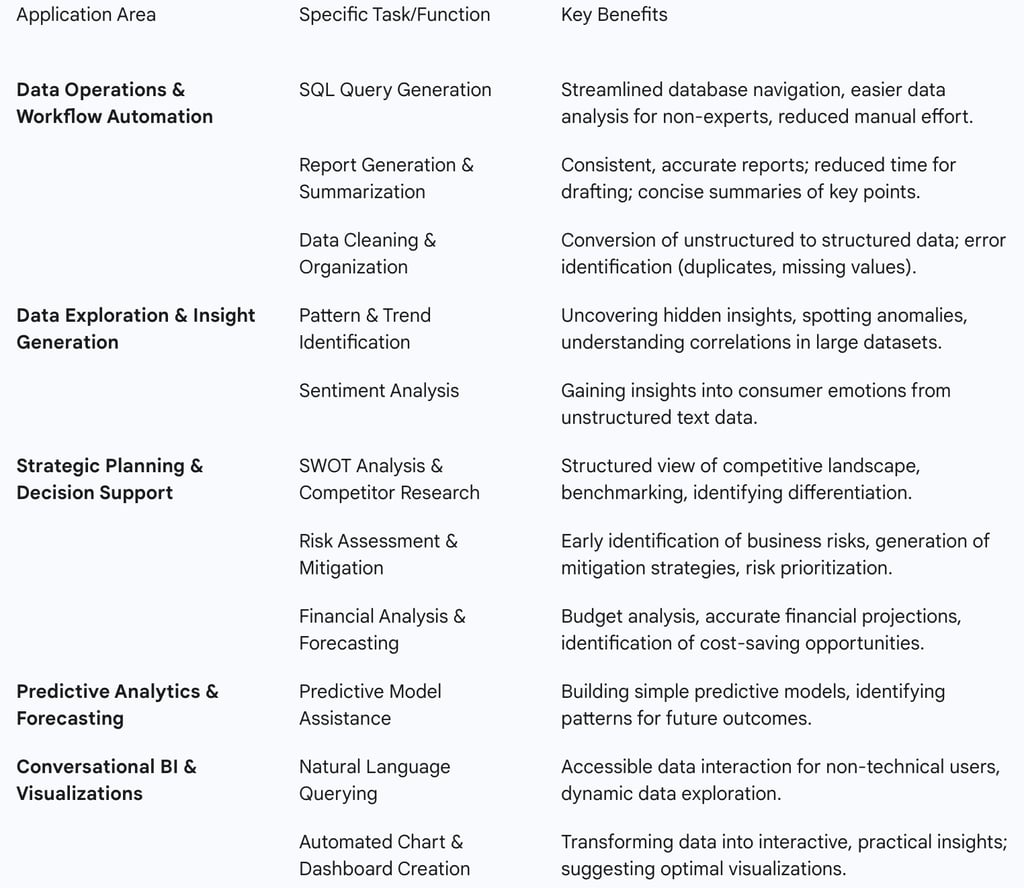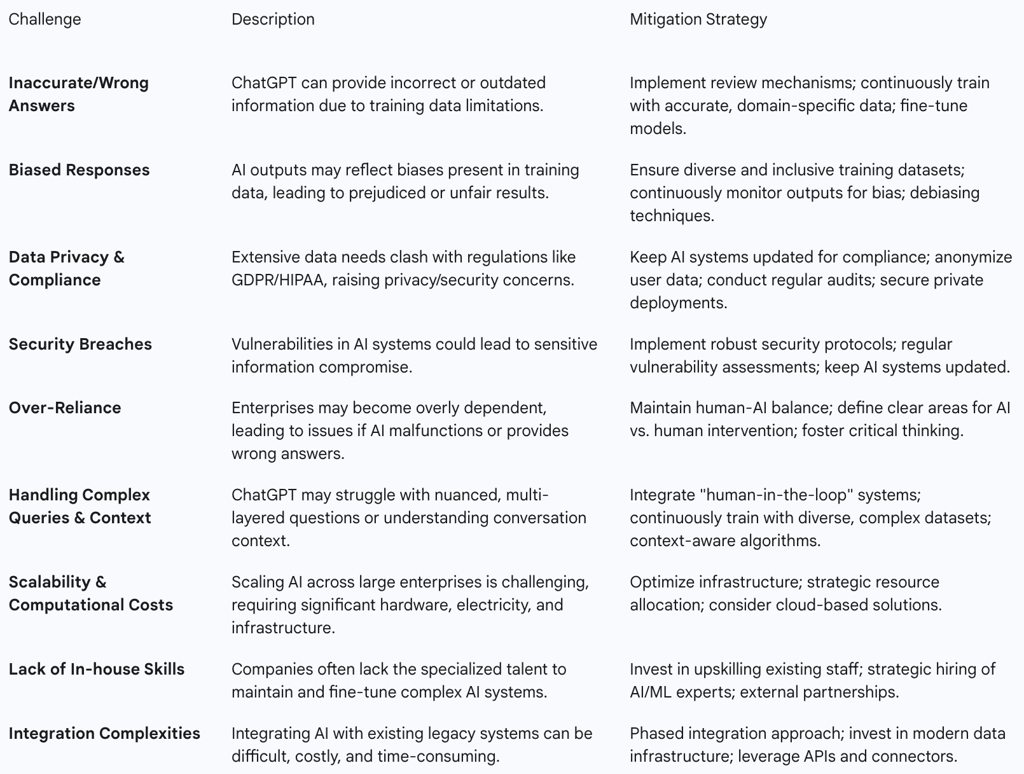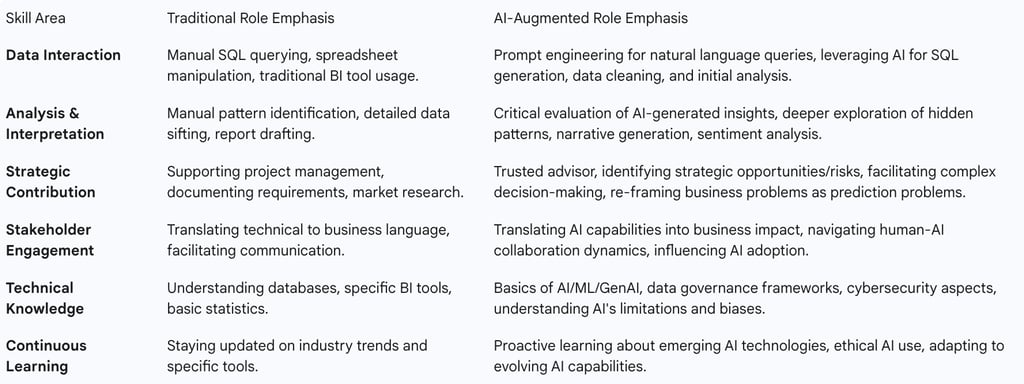The Impact of ChatGPT on Business Analytics
Explore how ChatGPT is transforming business analytics by enhancing data processing, predictive analytics, and decision-making. Discover the future of data-driven business strategies with AI integration.


ChatGPT is rapidly reshaping the landscape of business analytics, transitioning it from a complex, often siloed function into a more accessible, efficient, and strategically integrated capability. By automating routine tasks, enhancing data interpretation, and empowering strategic decision-making, ChatGPT offers significant opportunities for organizations to unlock deeper value from their data assets and drive growth. However, its adoption is not without challenges, including concerns around data accuracy, bias, privacy, and the need for substantial computational resources and specialized skills. The role of the business analyst is consequently evolving, shifting from data manipulation to higher-value strategic advisory, necessitating new competencies in human-AI collaboration and critical evaluation. Navigating this transformation successfully requires a strategic, phased approach, investing in robust data governance, AI literacy, and fostering a culture that embraces AI as a powerful augmentation to human intelligence.
ChatGPT's Emergence in Business Analytics
The advent of advanced artificial intelligence (AI) models, particularly large language models (LLMs) such as OpenAI's ChatGPT, marks a pivotal moment in the evolution of business analytics. ChatGPT, a sophisticated language model, is designed to generate human-like text responses based on provided prompts, extending its utility far beyond simple conversation to encompass complex analytical and generative tasks. This capability positions it as a powerful tool for businesses seeking to extract greater value from their data.
The field of business analytics itself is undergoing a profound transformation, driven by the exponential growth of data and the escalating demand for real-time, actionable insights. Traditional analytical methods often struggle to keep pace with the sheer volume and complexity of modern datasets. In this dynamic environment, ChatGPT emerges as a critical enabler, promising to bridge the gap between raw data and strategic decision-making by simplifying intricate processes and democratizing access to insights. The analysis indicates a fundamental shift in the very nature of decision-making currency, moving beyond merely understanding past events to actively predicting future outcomes and prescribing optimal actions. This trajectory suggests that the integration of AI, exemplified by ChatGPT, is not merely an incremental improvement but a strategic imperative. Businesses that delay in leveraging such AI capabilities risk falling behind in an increasingly data-driven economy. This underscores that the decision to integrate LLMs into business analytics is a critical strategic choice with significant long-term implications for market positioning and profitability.
Transforming Business Analytics: Key Capabilities of ChatGPT
ChatGPT's integration into business analytics workflows represents a paradigm shift, fundamentally altering how data is processed, interpreted, and leveraged for strategic advantage.
2.1. Streamlining Data Operations and Workflow Automation
ChatGPT's ability to automate and simplify repetitive, time-consuming data tasks significantly enhances efficiency across the business analytics workflow.
One notable capability is the automation of SQL query generation. ChatGPT can significantly streamline the process of writing SQL queries, a foundational skill in data analysis. It makes it easier for analysts, even those without extensive SQL knowledge, to navigate databases and perform data analysis tasks. It can guide users through syntax, assist with table joins, filter data effectively, and aggregate results. Furthermore, it can provide insights into troubleshooting errors and optimizing query performance. For business analysts, this translates to faster data extraction and preparation, freeing up time previously spent on intricate coding.
Beyond queries, ChatGPT aids in data cleaning and organization. It can simplify data handling by converting unstructured information into structured forms like tables or spreadsheets. It also possesses the ability to identify and suggest fixes for errors, inconsistencies, duplicates, or missing values in datasets, proposing appropriate imputation methods or standardization techniques. This pre-processing capability ensures higher data quality for subsequent analysis, which is critical for reliable insights.
The model also excels at automating report generation and summarization. Businesses can utilize ChatGPT to generate structured reports, such as sales updates, project progress reports, or market analyses, ensuring consistency and inclusion of all necessary elements. It can condense meeting transcripts or notes into concise, coherent reports that capture key points, action items, and decisions. This capability saves hours of manual effort , allowing for faster delivery of critical information. Prompts can be meticulously crafted to define the report's purpose, key points, and desired tone, enabling ChatGPT to generate tailored content.
More broadly, ChatGPT facilitates general workflow automation. It can automate various repetitive tasks, such as onboarding checklists, compliance forms, or task delegation, thereby freeing up valuable time for more critical, strategic activities.
The automation of routine, time-consuming tasks like SQL query writing, data cleaning, and report generation directly leads to a significant reduction in the manual workload on business analysts. This reduction in operational burden allows analysts to reallocate their time and cognitive energy towards higher-value activities, such as in-depth analysis, strategic planning, and stakeholder engagement. This qualitative shift in the nature of analytical work means that automation of mundane tasks enables increased capacity for strategic thinking and problem-solving, ultimately boosting overall organizational productivity and the strategic impact of the analytics function. Furthermore, the simplification of complex tasks, such as SQL query writing for users without extensive knowledge or generating reports from prompts , signifies that basic data operations are no longer exclusive to highly technical roles. This enables a broader range of business users to interact with and extract value from data directly. The implication is a reduced bottleneck on specialized data teams, faster turnaround times for simple requests, and a more data-literate workforce across the organization.
2.2. Enhancing Data Exploration and Insight Generation
ChatGPT empowers analysts to delve deeper into data, uncover hidden insights, and make complex information more accessible.
A core strength of ChatGPT is its ability for in-depth data exploration and pattern recognition. It can provide a more thorough exploration of datasets by generating insightful summaries and identifying key trends, patterns, anomalies, and correlations within large datasets that might be overlooked by traditional methods or human analysts. This capability allows for a deeper understanding of underlying data dynamics.
The model is also "extremely useful in summarising large datasets into key insights," providing a "quick narrative" of the data. This makes complex data more accessible to non-technical stakeholders, fostering broader understanding and engagement across the organization.
A key advantage is ChatGPT's contextual understanding. Its ability to retain context within a conversation allows users to ask follow-up questions while the system remembers the original analysis's focus, creating a smooth and natural conversational experience.
Moreover, ChatGPT is adept at unlocking unstructured data. It can analyze large volumes of unstructured information, such as social media posts, customer feedback, and support tickets, to identify patterns and trends. This includes performing sentiment analysis on text data to gain valuable insights into consumer sentiments, a capability that traditional methods often struggle with.
The rapid pattern recognition and ability to generate insightful summaries from vast datasets significantly accelerate the data exploration phase. This means analysts can move from raw data to actionable information much faster than before. The implication is that businesses can react more quickly to market shifts, identify opportunities sooner, and gain a competitive edge by leveraging real-time information. Furthermore, by translating complex data into plain language narratives and suggesting effective visualizations , ChatGPT empowers business analysts to become better data storytellers. This moves beyond simply presenting numbers to explaining their meaning and implications in a compelling way, which is crucial for influencing decision-makers and fostering data literacy across the organization.
2.3. Empowering Strategic Planning and Decision Support
ChatGPT extends its utility beyond raw data processing to support higher-level strategic functions, enabling more informed and proactive decision-making.
The model can assist in gaining crucial business and industry insights, helping align initiatives with company goals and driving growth. It can also help in identifying Key Performance Indicators (KPIs) relevant to a business, allowing for better planning and prioritization of efforts that address strategic business priorities.
For market analysis, ChatGPT facilitates SWOT (Strengths, Weaknesses, Opportunities, Threats) analysis and competitor research. Analysts can use it to generate comprehensive SWOT analyses for their organization or competitors, providing a structured view of the competitive landscape. It can also summarize key strategies employed by rival organizations, enabling businesses to benchmark performance and identify areas for improvement or differentiation.
In terms of operations, ChatGPT aids in process modeling and optimization. It helps in creating visual process flow diagrams, identifying inefficiencies or bottlenecks in workflows, and suggesting improvements based on best practices. This capability helps streamline processes and enhance overall operational efficiency.
For risk management, ChatGPT supports risk assessment and mitigation. It can assist in identifying potential business risks by analyzing historical data and current trends. Once risks are identified, ChatGPT can generate tailored mitigation strategies based on industry standards or organizational practices, helping to minimize disruptions. It also helps prioritize risks based on their potential impact and likelihood.
In financial functions, ChatGPT enhances financial analysis and forecasting. It streamlines budget analysis by quickly processing financial data and generating insights regarding spending patterns or budget variances. It assists in generating accurate financial projections for future periods, which are essential for informed decision-making regarding investments, resource allocation, and strategic initiatives. It can also identify cost-saving opportunities.
By rapidly synthesizing information for strategic tools like SWOT analyses and providing insights for financial projections , ChatGPT significantly accelerates the strategic planning cycle. This allows business leaders to consider more scenarios and make faster, more data-informed decisions in a dynamic market environment. The implication is a shift towards more agile and responsive business strategies. Furthermore, ChatGPT's ability to identify potential business risks early by analyzing historical data and trends and then suggest mitigation strategies transforms risk management from a reactive to a proactive function. This allows organizations to anticipate and address threats before they escalate, protecting assets and ensuring business continuity.
2.4. Advancing Predictive Analytics and Forecasting
ChatGPT's capabilities extend to supporting predictive analytics, enabling businesses to forecast future trends and outcomes with greater ease.
The model can provide assistance in predictive modeling. It can help in building simple predictive models and identifying patterns that indicate future outcomes based on historical data. It aids in preparing data, identifying relevant variables, and communicating with the model using natural language prompts.
For forecasting future trends, ChatGPT can analyze customer behavior patterns from past data and market trends to predict future behaviors. It can provide forecasts with confidence intervals and suggest factors influencing future performance.
While not a full replacement for specialized machine learning models for critical predictions, ChatGPT offers valuable support for data scientists. It can aid them by generating code snippets for data processing and suggesting features for model building. It serves as an excellent learning and brainstorming tool for developing predictive capabilities.
ChatGPT makes predictive analytics more accessible to a broader audience, including those without deep data science expertise. By simplifying the process of identifying patterns and forecasting trends , it empowers more business users to leverage predictive insights in their daily operations. This leads to more data-driven decisions being made at various organizational levels, not just by specialized teams. The ability to leverage ChatGPT for predictive analytics also allows businesses to forecast future demand, costs, or risks with greater precision. This shifts the organizational mindset from reacting to past events to proactively planning for future scenarios. The implication is improved resource allocation, optimized marketing campaigns, and a more resilient supply chain.
2.5. Facilitating Conversational BI and Interactive Visualizations
ChatGPT is transforming how users interact with business intelligence (BI) tools, moving from static reports to dynamic, conversational data exploration.
The rise of natural language interfaces (NLI) in BI tools is a significant development. ChatGPT enables users to interact with data using everyday language queries or conversational prompts, making data analysis substantially easier for non-technical users. This eliminates the need for users to learn SQL or complex visualization tools.
This integration fosters a shift from static dashboards to dynamic conversations. The BI landscape moves from rigid data structures and predetermined questions to dynamic, interactive conversations. A key advantage is ChatGPT's ability to retain context within a conversation, allowing users to ask follow-up questions while the system remembers the original analysis focus. This creates a seamless, natural interaction.
ChatGPT also facilitates automated chart and dashboard creation. Users can describe the dashboard or chart they want, and ChatGPT can automatically build it, suggesting the best chart type for the dataset. It can create various static and interactive visualizations, including bar, pie, scatter, and line charts, and can customize their graphics. It also helps streamline dashboard structures and refine filters.
Furthermore, ChatGPT can be integrated with existing BI platforms like Microsoft Power BI, allowing users to interact with their data using natural language queries within the BI environment. This integration leverages Power BI's APIs to fetch data and provide real-time insights.
Finally, ChatGPT assists in "effective storytelling with data" by helping translate numbers and statistics into graphs, charts, and infographics that tell a compelling story.
The shift from static dashboards to dynamic, conversational interfaces fundamentally democratizes access to business intelligence. Non-technical users can now directly query data and generate visualizations without relying on IT or data teams. This reduces bottlenecks, speeds up insight generation, and fosters a truly data-driven culture across all departments, not just the analytics team. Moreover, ChatGPT's ability to maintain context and provide human-like responses creates a highly intuitive and engaging user experience for data exploration. This improved interaction can lead to greater adoption of BI tools across the organization, as users find it easier and more rewarding to extract insights, implying a higher return on investment for BI platforms and a more data-literate workforce.
Real-World Applications and Case Studies
The theoretical capabilities of ChatGPT are being rapidly translated into tangible business value across diverse industries. These real-world applications demonstrate its versatility and the significant operational efficiencies and strategic advantages it can offer.
In e-commerce, a company implemented ChatGPT for automated customer service, managing frequently asked questions. This led to a dramatic reduction in response time from 24 hours to instant, and a 40% increase in customer satisfaction. This illustrates how analytical insights derived from customer queries can be directly actioned to improve service. Online stores also leverage ChatGPT for enhanced product recommendations, analyzing visitor data (from CRM and site interactions) to provide personalized selections, resulting in significantly higher conversion rates for suggested products. ChatGPT further automates the writing of SEO-optimized product descriptions from basic specifications, proving highly cost-effective and efficient.
Within the healthcare sector, a medical clinic utilized ChatGPT to create a virtual appointment assistant. This resulted in a 30% reduction in administrative time and improved scheduling accuracy , freeing up staff for more critical patient care, enabled by efficient data management.
In retail, a store deployed a ChatGPT-based chatbot to offer personalized product recommendations, leading to a 25% increase in online sales. This showcases the power of AI-driven personalization derived from customer data analysis.
For IT and technical support, an IT company integrated ChatGPT into its technical support system, reducing average problem resolution time and improving end-user satisfaction. ChatGPT also assists in debugging code, troubleshooting errors in real-time, and generating Python scripts for data processing and analysis.
In marketing and content creation, digital marketing agencies use ChatGPT to automatically respond to social media queries, improving customer engagement and freeing staff for creative tasks. It generates human-like content for articles, blogs, and social media posts, and can automate content curation based on user preferences. Furthermore, ChatGPT aids in SEO by rewriting content while preserving HTML structure and optimizing for keywords, significantly speeding up content adaptation for new markets.
In financial services, a mid-sized bank offered a ChatGPT-based educational chatbot to help customers understand financial products, leading to higher customer retention. ChatGPT can also automate financial analysis and decision-making processes, analyzing market trends for investment opportunities.
Finally, in human resources, a technology company automated responses to frequently asked employee questions about benefits and policies, saving time and improving internal communication. It can also assist in screening resumes and conducting initial interviews, saving HR teams time and effort.
The case studies consistently demonstrate how analytical capabilities powered by ChatGPT (e.g., understanding customer queries, analyzing visitor data, processing reviews) translate directly into measurable business outcomes like increased sales, improved customer satisfaction, and reduced operational costs. This reinforces that ChatGPT is not just an analytical tool but a driver of tangible business value. The examples span diverse sectors (e-commerce, medical, retail, IT), highlighting ChatGPT's adaptability and broad applicability beyond traditional tech domains, implying that the impact is not niche but pervasive across the modern economy. While the report focuses on business analytics, many case studies (e.g., customer service, HR, marketing) show how analytical insights powered by ChatGPT contribute to broader operational improvements and strategic goals. This reinforces the idea that business analytics is an enabler for wider business transformation.
Table 1: Key Applications of ChatGPT in Business Analytics






